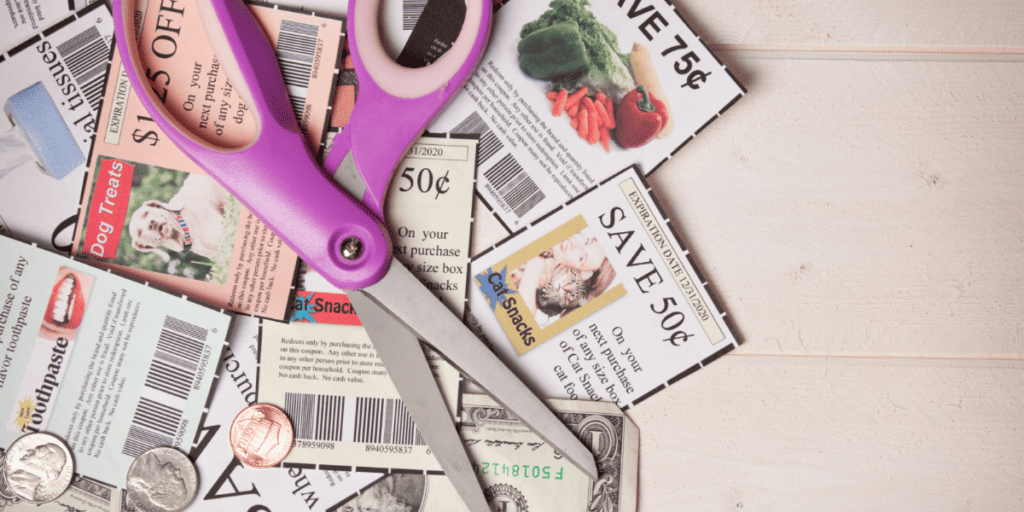This site may contain affiliate links, view the Disclaimer for more information.
”What’s for dinner?” Should not be a stress-inducing, heavy-loaded question. Sweaty palms, heart palpitations, and a headache should not happen when trying to stay under or even within your budget. However, IT IS possible to meal plan on a budget.
Imagine this, for a minute: You need to know how to meal plan for a family of four. You are a one income household with a mortgage, health insurance, hospital bills, utilities, and a sprinkle of debt. You are trying to get your finances in order because you are finally tired of living paycheck to paycheck.
Making the most amount of money you have ever made and yet, it still doesn’t seem like enough. Trust me, I know the feeling. It still feels like too many months for the amount of money we earn.
You truly don’t know where to start on creating a realistic and manageable dollar amount to spend on groceries every month. We all know buying groceries is the one thing we can control but typically overspend. Well, first, take a deep breath. Second, let’s dive into this post about how to create a meal plan on a budget.
1. Where does your Money Go?
The first thing is to have a budget. I won’t go into much detail (that’s for another post) but gather all your expenses and debts on a spreadsheet. How much can you actually afford to spend on groceries a month?
How much debt are you in? What can you cut out? You need to know all this before creating a weekly meal plan on a budget.
2. What kind of Meals Does your Family Enjoy?
Now, that you have a budget and a better idea of how much you can spend, what are some foods you enjoy? Are they simple, expensive, or all over the place?
Meal planning on a budget is more than just saying we like eating x,y,z and that is what will be on the menu. However, this will help create a template for some themes you can incorporate every week (more on that later in the post).
3. Have an Inventory Day

Walmart, Target, and every business in between all have inventory and times they count it. Why? To use what they have, and see what they need. To not overspend and stay within a set budget.
This time period helps them save money by not buying more than they need and being resourceful with what they have already. Think of your household as a business and you the BOSS.
You and your family need to check the pantry, freezer, fridge, and any other places you stash food. Write down what you have from each section of your house that holds food. You’ll be able to have a better idea of what’s needed.
I can’t tell the number of times I wound up having 15 cans of seasoned black beans because I’m not routinely looking in my cabinets. Although, it’s a few cents it starts to add up over time.
4. What are the Themes of the Week?
Creating themes to adhere to helps defeat decision fatigue and takes a lot of the guesswork of creating a weekly meal plan. Some examples my family and I use:
- Burger Monday
- Taco Tuesday
- Pasta Wednesday
- No Meat Thursday
- Easy Friday
- Fun Saturday
- Slow Cooker Sunday
I choose one meal from each category out of my recipe binder to help curate a grocery list of needed items based on what’s already in my house. Breakfast is usually cereal, yogurts, or pancakes in our house so we don’t have a category for that. But you tailor this to your family’s needs and wants.
After we have created the themes, there’s one thing we need to do before writing and finalizing our grocery list. We need to know what’s on sale for the week.
5. Shop the Sales

Bring out those trusty weekly Ad papers. Choose from your favorite stores or even stores around your neighborhood and start pricing. Walmart typically does not have weekly sales but they do have rollbacks and tend to be cheaper already.
However, that doesn’t mean your other local grocery stores can’t beat their normal price from time to time. To gauge whether or not it’s a good sale, I price compare to Walmart. If I can get it cheaper at Walmart (not on rollback) then I move on to the next sale item.
What kind of beef is on sale? Is it ground beef; that can go towards Taco Tuesday and/or Burger Monday. Go for the bigger pack of ground beef and freeze a portion away for later use. Chicken thighs, breast, and leg quarters are all .99 cents a pound? Stock up even if you hadn’t planned on using chicken this week. They will be added to the freezer stash.
You’ll only use a portion of your grocery budget to begin stocking up for meals later. Shopping and using what’s on sale for the week, allows you to save hundreds of dollars while slowly building a stash for the future.
Bonus Tip: Add a grocery store rebate like Ibotta or Shopkick to get cash back on qualifying purchases. You can then redeem those earnings for gift cards or real cash.
6. Bring out your Recipe Binder & Pinterest

Let’s recap up to this point. We figured out a budget, we have a general idea of what the family likes to eat, we took inventory of the food in the house, we have weekly themes, and we looked at what was on sale.
Now, it’s time to figure out a meal plan. We need to generate some recipe ideas to use all of this. Let’s look at an example.
Inventory List
Pantry
- Fire roasted corn
- Canned Black beans
- Canned Red beans
- Chicken broth
- BBQ Sauce
- Penne Noodles
- Canned Tuna
- Tortillas
Fridge
- Bacon
- Cilantro
- Bell Peppers
- Red Onion
- Eggs
- Zucchini
- Pesto Sauce
- Mozzarella Cheese
Freezer
- Meatballs
- Salmon
- Pork Butt
The Sale items for the week are ground beef, sausage, chicken legs, and chuck roast. We have made the following meal plan based on the sales, inventory, and themes. Look through your recipe binder and Pinterest for tried or new menu choices.
(We tried this Parmesan Italian chicken breast recipe from Pinterest. It was sooo yummy and juicy and cost almost nothing to make. I already had frozen chicken breast, grated Parmesan cheese, and Italian dressing on hand. Plus, that’s all you needed besides salt and pepper.)
Menu for the Week
- Sausage Hash-brown Casserole
- Pesto Burgers
- Pork Carnitas
- Penne Carbonara
- Veggie Fajitas
- BBQ Chicken legs
- Meatball Sub Sandwiches
- Slow Cooker Red Beans & Rice
Now, we just need to shop for what we do not have to complete the meals.
7. Supplementing
Congrats! You have made it to the final stage of your meal plan. I consider this to be the fun part. It’s almost like a little game challenge of how little can I spend.
If you have a rebate app, I would pull that up now. Quickly scan to see if anything applies to your list for some cash-back goodness. Once that is done, all you need to do is shop for everything you need to complete the meals.
This is also the time to gather one to two extra sale meats/items to start building up a freezer or pantry stash. Start small if you have a tight budget or if you don’t have much storage space.
Extra Money Saving Meal Plan Tip: Buy Generic when you can and on items that aren’t family favorites. Also, throw in a plant-based meal or two. This will cause you to buy and use less meat; as meat is usually the most expensive item.
Unpopular opinion: Not everything generic tastes good or the same as its counterpart. As much as people LOVE to push that idea, not everything generic is created equal in my humble opinion. So I do a mixture of buying generic items and our must-have name-brand favorites. It doesn’t save anyone any money if you buy everything generic and throw it out because your family hates it. However, if you truly have a tight budget or some serious debt-crushing goals, generic is usually the way to go.
8. Enjoy the Savings

A round of applause for you! You not only meal planned for the week, you saved a ton of money, you also got organized (If you didn’t already have a recipe binder), and nothing in the home is getting wasted. You’ll have a growing freezer/pantry stash for future meals that you didn’t pay full price for.
I can’t wait to hear how much this has helped you and your family find some wiggle room in the budget. You can use that extra money to save or tackle any debts you have. This post was all about developing a meal plan on a budget.
Psssst. You can also apply the same techniques to consumables. Consumables are non-food items that usually need once or twice a month buying. Such as toilet paper, dish soap, deodorant, etc. Basically, all the nonfood items you can find in grocery stores.
(To save money, purchase your consumables within your set grocery budget. So if your grocery budget is $500 for the month, that will include toothpaste, toilet paper, and baby wipes/diapers along with your food.)






One Comment
Comments are closed.